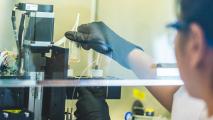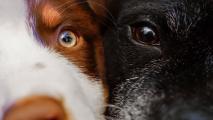3D-printed halo helps dog adjust to life without eyesight
We’ve seen 3D printing used to help hospitals, heart-disease patients, and people with Parkinson’s. The latest benefactor of the tech? An 18-year-old dog named Sienna.
Like many seniors, the two-and-a-half pound Pomeranian’s eyesight is failing her, resulting in collisions with door frames and walls.
But Sienna is lucky, because her owner, Chad Lalande, has a brand-new 3D printer — and a knack for designing assistive devices for pets.
The Blind Dog Halo
There are devices called “blind dog halos,” designed to help dogs with vision problems like Sienna get around.
As the name implies, these devices look like a halo that goes around a dog’s head, and they act like a bumper — before the animal runs into something, the halo will hit it first.
However, blind dog halos can be pricey, and Lalande wasn’t sure he’d be able to find one to fit the diminutive Sienna, so he decided to see if he could create something for her using the 3D printer he’d gotten for Christmas 2020.
Using two software programs (LightWave 3D and Cura), Lalande designed his own version of a blind dog halo, but as he told Gizmodo, the first prototype he printed was too narrow — Sienna could still poke her head over it to bump into things.
The next couple of prototypes were wider, but also heavier — the front of the hoop kept falling toward the floor when Sienna wore the halo.
At the suggestion of a member of a 3D printing Facebook group, Lalande added a curved bar from the front of the hoop, over Sienna’s head, to the part of the device circling her neck.
The sixth prototype based on that design turned out to be perfect.
It kept Sienna from bumping into things, and, thanks to the extra bar, she also couldn’t get it stuck under doors, which had been a problem with earlier designs.
“Sienna doesn’t like to wear it all that much,” Lalande told Freethink, “but it is still better than banging her head into things.”
3D Printing FTW
Sienna’s blind dog halo marked the first time Lalande had 3D printed a device for a dog, but it wasn’t the first time he engineered something to help a pet in need.
When his sister’s collie started having trouble lifting its feet, he used fabric and elastic bands to create dog boots that attached to the animal’s harness, helping it walk without tripping.
Then, when his dad’s dog Timmy started having trouble walking, Lalande built a wheelchair for him out of a harness and aluminum rods.
It was so much easier and cheaper to do this kind of thing with a computer and 3D printer.
Chad Lalande
3D printing made the designing and prototyping process far easier, though.
Instead of trying to visualize a design in his head, Lalande could lay it all out on his computer. Then, when he had a design he liked, he could print it, try it on Sienna, make changes, and print a new prototype.
“It cost about $25 in filament for all the devices I printed,” he said. “When I made the doggie wheelchair and anti-drag foot boots, making changes meant running to town to pick up supplies and then tearing the old design apart.”
“It was so much easier and cheaper to do this kind of thing with a computer and 3D printer,” he continued. “Especially now with the restrictions in place due to the virus.”
Open Source Halo
Lalande has made his designs for the blind dog halo available on Thingiverse, but he’s not sure many people will be able to use it — it’s designed to be printed in one piece and requires a larger build plate than most 3D printers have.
“It would have to be made in sections and glued together when printed on these printers,” he said. “The model is not elegant enough to just chop it up for printing, or at least that’s my thinking.”
Even if someone could print that design, it likely wouldn’t be big enough for their dog — Sienna is really, really small.
Lalande said he does plan to design a version of the device that would fit larger dogs and be printable in sections — his sister’s new collie and his own Siberian Husky will be the test subjects for that.
We’d love to hear from you! If you have a comment about this article or if you have a tip for a future Freethink story, please email us at [email protected].





